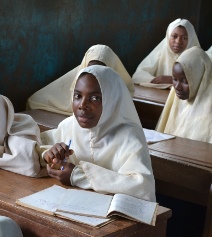 A new Topic Guide on Inclusive Learning in low and middle-income countries
A new Topic Guide on Inclusive Learning in low and middle-income countries
What works when we try to include children with disabilities and learning difficulties in regular schools in low and middle-income countries? What doesn’t work?
These are the questions that a new
Topic Guide on Inclusive Learning addresses. It is designed to support policy-makers, educational planners, practitioners and advocates in the drive to ensure all children are included and engaged in schools worldwide. The guide was produced by the Health & Education Advice & Resource Team (HEART) funded by the U.K. Department for International Development (DFID).
Free schooling is not always the answer
Since 2000, strategies to achieve mass access to education have made schooling a reality for boys and girls from urban centers, high-income households and for those fortunate enough to live in countries where equitable and meaningful access to quality education has been created. International commitments, government policies, civil society engagement and economic growth have helped to make progress happen, and yet fee-free schooling has not been a cure to achieve universal enrolment.
Disability continues to be one of the most neglected causes of educational disadvantage, even though girls and boys with disabilities are disproportionately represented among those excluded from schooling. Four out of every five children with disabilities live in developing countries. The highest levels of moderate and severe disabilities are found in sub-Saharan Africa.
In Malawi and Tanzania, for instance, disability doubles the probability of never attending school. In Burkina Faso, it increases the risk of children being out of school by two and a half times. Disability also makes it less likely for girls and boys to complete their schooling.
Inclusive schooling supports economic growth
The economic growth that is essential to a renewed, sustainable development agenda will fail without inclusion and a commitment to tackle head on the barriers that perpetuate poverty and vulnerability.
If we want everyone to benefit from growth, we need policies that directly target the discrimination and extreme deprivation experienced by marginalized groups, including children with disabilities. Access to good quality basic education reduces poverty and improves health and livelihoods. It also enables people to fulfil their potential and contribute to open, inclusive and economically vibrant societies.
The costs of exclusion are high
In Bangladesh for example, foregone income due to a lack of schooling and employment for people with disabilities and their caregivers is estimated at US$1.2 billion annually, or 1.74% of the gross domestic product (GDP).
More generally, a recent study showed that the economic cost of out-of-school girls and boys is greater than the value of an entire year of GDP growth in nine countries: Burkina Faso, Cote d’Ivoire, Gambia, Lesotho, Liberia, Mali, Nigeria, Senegal and Yemen.
Even for large middle-income countries with low out-of-school populations, such as Brazil and Indonesia, the cost of out-of-school children outweighs the additional public spending required to enroll them making it an equitable and cost-effective investment.
Lack of data is a problem
Lack of detailed national data and cross-country benchmarks has limited the ability of governments, donors and others to assess, monitor and address the situation of children with disabilities.
Although the picture is changing with new survey tools, guidelines, toolkits and capacity building programs planned for 2015 by the Washington Group and UNICEF, the political will and commitment to drive improvements in data collection and management has been insufficient. This has hindered action at national and international levels.
Systemic challenges, such as divided ministerial responsibility across education, health and social protection have also been a barrier to education for children with disabilities. Often, the focus of support is shifted to social welfare and ‘special’ treatment, rather than inclusion and equity.
Disability – an intractable problem?
The absence or inadequacy of legislation, strategies and targets prevents the inclusion of girls and boys with disabilities in education. This is on top of school-level barriers such as physical access, inappropriate curricula and pedagogy, inadequate teacher training and labelling and discriminatory attitudes that reinforce the marginalization.
The complexities in addressing the specific needs of children with disabilities or difficulties in learning may not arise when designing interventions for other marginalized groups, such as those living in slums or remote rural areas. This has challenged policymakers and made disability seem like an intractable “problem” for the sector.
Extending education opportunities to all children, including those with disabilities, requires more than building new schools and improving learning outcomes.
We need policies and other system-wide interventions that directly target boys and girls with disabilities and the underlying causes of disadvantage, along with political support and effective leadership.
One size does not fit all as countries face their own specific constraints, challenges and opportunities. Action to ensure the inclusion of learners with disabilities works best when it is tailored to local and individual circumstances.
New Topic Guide on Inclusive Learning
The new Topic Guide on Inclusive Learning builds on the renewed global focus on learning, and responds to growing concerns about the estimated 250 million children who don’t learn despite attending four years of school. The guide highlights the importance global strategies that prioritize the diverse learning needs of the most marginalized children.
We discuss key concepts associated with inclusion and inclusive learning, terminology related to disability, and the difficulties in collecting appropriate data. We also address some of the dilemmas of providing specialist support for girls and boys with disabilities, while at the same time promoting generic inclusion.
The body of evidence on inclusive learning in low- and middle-income countries, though weak and fragmented, is presented, with a particular focus on classroom practice, teacher education, school leadership and community engagement. Finally, we explore the relationship between inclusive learning and development more broadly and suggest an agenda for future research directions.
Written by Juliette Myers, an independent consultant and co-author of the Topic Guide on Inclusive Learning.

